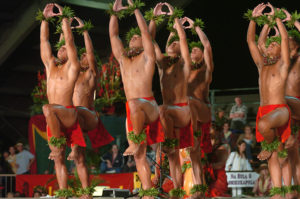This article was originally published in 2018. For the latest Kilauea Volcano’s status, please visit Kīlauea – Volcano Updates
Due to a new volcano eruption starting on May 3, 2018, the entire lava landscape of Hawaii Island is forever changed.
A popular Big Island odyssey is a drive to Hawaii Volcanoes National Park, where you can visit Kilauea Volcano. It’s a must-see for good reason. How often do you get to visit an erupting volcano? Most don’t realize, however, that this is not just a short side trip. No matter your starting point — with the exception of Volcano Village itself — prepare for a full day of driving, walking or hiking, and some superb sightseeing. See below for drive times and other tips.
This impressive park, with two active volcanoes (Kilauea and Mauna Loa), requires about half a day to see. Of the two volcanoes, Kilauea is much more accessible and is the most active. It has been erupting continuously since 1983. Mauna Loa is for the committed outdoors enthusiast.
The Kilauea Visitors Center is the place to start your tour of the park. After paying your US$10-per-car admission fee and getting a map, walk over to the Volcano House for a first glimpse of the crater. The nearby Volcano Art Center exhibits high-quality works by local artists. Call 808-967-8222 for more information.
What to Expect at Hawaii Volcanoes National Park
Volcanic activity in the national park is unpredictable, varying from day to day. Call 808-985-6000 for recorded updates. In most cases you will be able to observe lava. The prime place to see lava is at the viewing area at the end of Chain of Craters Road (the road ends because it, along with a visitors center, was wiped out by a lava flow). Marked trails lead to places where you can observe the flow; stick to designated areas at all times. Try to visit at dusk. The sun setting on the desolate landscape of hardened lava is spectacular, and the lava flowing into the sea can be best seen at night. Flashlights are required to find your way back to your car. The trails close at 9 p.m. A brief visit to the area will take less than an hour, but those who are fascinated by the spectacle may want to allow two or three hours.
Crater Rim Drive provides access to most of the other viewing areas in the park. Worthwhile stops include Steaming Bluff, the Jaggar Museum (displays on the geology and physics of volcanic activity — note the olivine crystals in the building’s columns), the Halemaumau Overlook (infants and those with respiratory problems should avoid this stop because of the sulfur), Devastation Trail (a forest killed in 1959 by a blanket of pumice ash), and the Thurston Lava Tube (a cave formed by lava located in the midst of a cool damp rain forest).
Hiking trails abound in the park: into dense rainforests, around steaming calderas and along lava flows. One of the most memorable walks is in Kipuka Puaulu, called Bird Park because of the many native birds you can see flitting between lehua blossoms and high above in the ohia trees. You can also walk into the Kilauea Caldera on a well-marked trail that starts at the Volcano House. Ask the park rangers about other trails.
If you’re not up to touring the park by car or foot, take one of the many coastal cruises or air tours.
Plan a Great Trip to Hawaii Volcanoes National Park
• Drive time, Kailua-Kona to Hawaii Volcanoes National Park: 2 hours
• Drive time, Hilo to Hawaii Volcanoes National Park: 45 minutes to 1 hour
• Drive time, Waikoloa to Hawaii Volcanoes National Park: 2.5 hours
• Drive time, Waimea to Hawaii Volcanoes National Park (via the Kona Coast): 3 hours
• Drive time, Waimea to Hawaii Volcanoes National Park (via the Hamakua Coast): 2.5 hours
• BEFORE STARTING YOUR JOURNEY, call Volcanoes National Park (808-985-6000) for Park conditions and tips on what you’ll need to take with you. Portions of the Park are sometimes closed to the public, due to shifting directions of the lava flow or inclement weather.
• Start driving in the morning. This will give you several hours of good daylight to explore the Park.
• Items to take with you, no matter what: water, sunscreen, umbrella, windbreaker and a sack lunch or snacks. The Park does offer a few places to eat, but if you’re out on the trail to the lava flow or on another hike, you’ll want to have food and water along.
• The Park’s trails close at 9 p.m. daily
• If you plan to hike to the lava flow at night (the lava’s orange glow is stunning in the dark), be sure to bring a flashlight for each person in your party. The trail is very dark. And remember: Never go off the trail.
UPDATE: Tuesday, July 26, 2016 – Lava Reaches the Sea!
The lava flow from Kilauea’s Pu‘u ‘O‘o vent dipped into the ocean early Tuesday morning less than 12 hours after crossing the Kalapana emergency route.
Hawaiian Volcano Observatory said the flow reached the ocean at 1:12 a.m. inside Hawaii Volcanoes National Park. It had crossed the gravel roadway at 3:20 p.m. Monday.
Janet Babb, a spokeswoman for the Hawaiian Volcano Observatory, said the ocean entry is the first time lava has reached the ocean since August of 2013.
Babb said it is impossible to predict how long the ocean entry will last.
The last lava flow to enter the ocean, the Peace Day flow, made its first entry in 2011 and the ocean entry continued — off and on and in different locations — until 2013.
Observatory geologists warned visitors that there are significant hazards for people wanting to hike to the area where the lava is entering the ocean. The hardened lava is uneven and unstable and there are “extremely steep sea cliffs,” scientists said. “Venturing too close to an ocean entry exposes you to flying debris created by the explosive interaction between lava and water. Also new land created in unstable because it is built on unconsolidated lava fragments and sand. This loose material can easily be eroded away by surf causing the new land to become unsupported and slide into the sea. Finally, the interaction of lava with the ocean creates an acidic plume laden with fine volcanic particles that can irritate the skin, eyes and lungs.”







